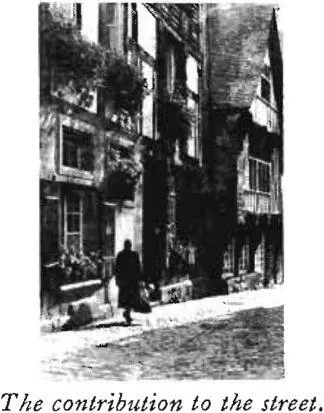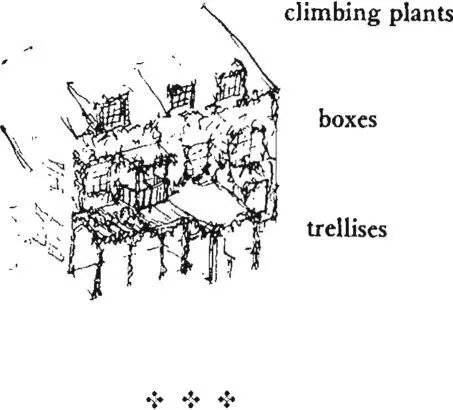Christopher alexander - A pattern language
Здесь есть возможность читать онлайн «Christopher alexander - A pattern language» весь текст электронной книги совершенно бесплатно (целиком полную версию без сокращений). В некоторых случаях можно слушать аудио, скачать через торрент в формате fb2 и присутствует краткое содержание. Жанр: Прочая научная литература, на английском языке. Описание произведения, (предисловие) а так же отзывы посетителей доступны на портале библиотеки ЛибКат.
- Название:A pattern language
- Автор:
- Жанр:
- Год:неизвестен
- ISBN:нет данных
- Рейтинг книги:3 / 5. Голосов: 1
-
Избранное:Добавить в избранное
- Отзывы:
-
Ваша оценка:
- 60
- 1
- 2
- 3
- 4
- 5
A pattern language: краткое содержание, описание и аннотация
Предлагаем к чтению аннотацию, описание, краткое содержание или предисловие (зависит от того, что написал сам автор книги «A pattern language»). Если вы не нашли необходимую информацию о книге — напишите в комментариях, мы постараемся отыскать её.
A pattern language — читать онлайн бесплатно полную книгу (весь текст) целиком
Ниже представлен текст книги, разбитый по страницам. Система сохранения места последней прочитанной страницы, позволяет с удобством читать онлайн бесплатно книгу «A pattern language», без необходимости каждый раз заново искать на чём Вы остановились. Поставьте закладку, и сможете в любой момент перейти на страницу, на которой закончили чтение.
Интервал:
Закладка:
. . . two earlier patterns can be helped by climbing plants around the building: trellised walk(174) and filtered light(238).
A building finally becomes a part of its surroundings when the plants grow over parts of it as freely as they grow along the ground.
There is no doubt that buildings with roses or vines or honeysuckle growing on them mean much more to us than buildings whose walls are blank and bare. That is reason enough to plant wild clematis around the outside of a building, to make boxes to encourage plants to grow at higher storys, and to make frames and trellises for them to climb on.
We can think of four ways to ground this intuition in function.
1. One argument, consistent with others in the book, is that climbing plants effect a smooth transition between the built and the natural. A sort of blurring of the edges.
2. The quality of light. When the plants grow around the openings of buildings, they create a special kind of filtered light inside. This light is soft, reduces glare, and stark shadows— filtered light(238).
3. The sense of touch. Climbing and hanging plants also give the outside walls a close and subtle texture. The same kind of texture can be achieved in the building materials, but it is uniquely beautiful when it comes from a vine growing across a wall or winding around the eaves of an arcade. Then, the texture invites you to touch and smell it, to pick off a leaf. Perhaps most important, the texture of climbing plants is ever different; it is subtly different from day to day, as the wind and sun play upon it; and it is greatly different from season to season.
4. Tending the plants. When they are well-tended, healthy plants and flowers growing around the windows and out of flower boxes in the upper storys, make the street feel more
11 36 246 CLIMBING PLANTS
comfortable. They bespeak a social order of some repose within the buildings, and therefore it is comfortable to be on the streets —-one feels at home. It is as if the plants were a gift from the people inside to people on the street.

Therefore:
On sunny walls, train climbing plants to grow up round the openings in the wall—the windows, doors, porches, arcades, and trellises.
 |
| 1137 |
247 PAVING with cracks
BETWEEN THE STONES**

. . . many patterns call for paths and terraces and places where the outdoor areas around a building feel connected to the earth—green streets (51), path shape (121), private TERRACE ON THE STREET (140), OUTDOOR ROOM ( 16 3) , CONNECTION TO THE EARTH (l68), TERRACED SLOPE ( 169) . This
pattern provides a way of building the ground surface that makes these larger patterns come to life.
♦&*
Asphalt and concrete surfaces outdoors are easy to wash down, but they do nothing for us, nothing for the paths, and nothing for the rainwater and plants.
Look at a simple path, made by laying bricks or paving stones directly in the earth, with ample cracks between the stones. It is good to walk on, good for the plants, good for the passage of time, good for the rain. You walk from stone to stone, and feel the earth directly under foot. It does not crack, because as the earth settles, the stones move with the earth and gradually take on a rich uneven character. As time goes by, the very age and history of all the moments on that path are almost recorded in its slight unevenness. Plants and mosses and small flowers grow between the cracks. The cracks also help preserve the delicate ecology of worms and insects and beetles and the variety of plant species. And when it rains, the water goes directly to the ground ; there is no concentrated run-off, no danger of erosion, no loss of water in the ground around the path.
All these are good reasons to set paving stones loosely. As for the flat, smooth, hard concrete and asphalt surfaces, they have almost nothing to recommend them. They are built when people forget these small advantages that come about when paving is made out of individual stones with cracks between the stones.
Therefore:
On paths and terraces, lay paving stones with a i inch crack between the stones, so that grass and mosses and
1139
small flowers can grow between the stones. Lay the stones directly into earth, not into mortar, and, of course, use no cement or mortar in between the stones.
 |
| •$* |
Use paving with cracks, to help make paths and terraces which change and show the passage of time and so help people feel the earth beneath their feet— connection to the earth(168); the stones themselves are best if they are simple soft baked tiles— SOFT TILE AND BRICK(248) . . . .
I I4O
248 SOFT TILE AND BRICK
. . . several patterns call for the use of tiles and bricks—
CONNECTION TO THE EARTH( 168) , GOOD MATERIALS(2O7), FLOOR SURFACE(233), SITTING WALL(243), PAVING WITH CRACKS BETWEEN THE STONES(247).
♦%
How can a person feel the earth, or time, or any connection with his surroundings, when he is walking on the hard mechanical wash-easy surfaces of concrete, asphalt, hard-fired architectural paving bricks, or artificially concocted mixes like terrazo.
It is essential, above all, that the ground level surfaces we walk on—both around our buildings and indoors in those places like passages and kitchens where the floor has to be hard—be soft enough, at least, to show the passage of time, in gradual undulations and unevenness, that tell the story of a thousand passing feet, and make it clear that buildings are like people—not impervious and alien, but alive, changing with time, remembering the paths which people tread.
Nothing shows the passage of time so well as very soft, baked or lightly fired, bricks and tiles. They are among the cheapest tiles that can be made; they use ordinary clay, are biodegradable, and always develop a beautiful sense of wear and time in the undulations made by people walking over them.
In addition, those paved areas around a building required by connection to the earth(168) play a special role. They are the places which are halfway between the building—with its artificial materials—and the earth—which is entirely natural. To make this connection felt, the materials themselves must also be halfway, in character, between the building and the earth. Again, soft, lightly fixed tiles are most appropriate.
We consider this so important, that we advocate, specifically, that the people who are making the building, make the quantity of bricks and tiles they need for ground floor and outdoor surfaces—and that these be made in local clay and soft fired, in stacks, right on the site.
Читать дальшеИнтервал:
Закладка:
Похожие книги на «A pattern language»
Представляем Вашему вниманию похожие книги на «A pattern language» списком для выбора. Мы отобрали схожую по названию и смыслу литературу в надежде предоставить читателям больше вариантов отыскать новые, интересные, ещё непрочитанные произведения.
Обсуждение, отзывы о книге «A pattern language» и просто собственные мнения читателей. Оставьте ваши комментарии, напишите, что Вы думаете о произведении, его смысле или главных героях. Укажите что конкретно понравилось, а что нет, и почему Вы так считаете.












